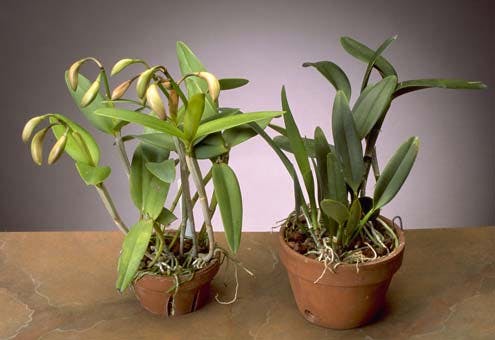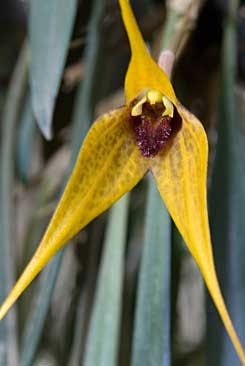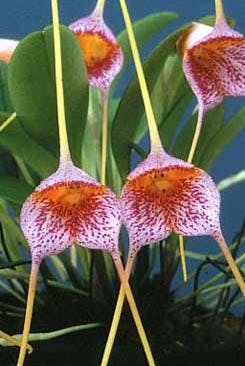
The plant on the left has received enough light to produce flowers while the one on the right has not. Note the difference in leaf color.
While there are many factors that can trigger blooming in orchids; a drop in night temperature, increase or decrease in day length and even sharp restriction in water availability, none of these will be successful unless your orchids have been grown with adequate light. For most hobbyists, this factor is almost always at the heart of the question "Why won't my orchids rebloom?" You can't work magic or miracles and without adequate light during the growing season, no amount of cajoling with decreased nitrogen, abusive cold nights, dehydration or similar abuse will result in flowering. If you have noticed a general decline in the number of your plants that flower, it's highly likely that the amount of light you have reaching your growing area has decreased. Don't forget that trees and landscaping grow as well and can eventually shade windows. I was once asked at a basic orchid culture class why one of the attendee's vandas no longer flowered. She explained to me that the first year she had amazing results, somewhat less the following year, last season only those on the outside edges bloomed and in the present season virtually none had flowered. My answer was she didn't have enough light. This prompted her to re-ask the question and insist there was plenty of light as the arbor had been especially constructed for her vandas. The second time she rejected my answer I asked if she'd trimmed the vines growing on the arbor. When she asked me how I knew she had planted vines, I said "you don't have enough light."

Ideally, most orchids should have light green foliage.
So what is adequate light? While the actual levels vary with the genus, in general orchid foliage should be a light yellow-green rather than a lush sort of grass green. In addition, the leaves of your plants should be firm and stand upright. Even Phalaenopsis which need relatively low light will, depending on the genetic background of the plant, hold their foliage horizontally or somewhat upright and plants that produce very long, floppy leaves are being grown under insufficient light. Think of the leaves being the plant-equivalent of solar collectors. The lower the light, the bigger the leaves need to be to gather the same amount of light; the heavier the leaves the harder it will be to hold them firm and upright.
There are several ways to gauge the light your plants are receiving and you can't really trust your eyes. Our eyes are designed to effectively adjust to the light they receive. Your local supermarket may appear to be very brightly lit when, in fact, the actual light level is less than 500 foot-candles (Phalenopsis need at least 2-3 times that level for adequate growth and flowering) and your office environment is typically about 1/5 of that level. While the most accurate way to measure light levels is to purchase a light meter you can get a pretty good estimate using just your hand. On a clear day, position yourself so that your hand is between your plants and the light source and about 12 inches from the leaves and observe the shadow, if any, your hand casts. If you can see no shadow, you probably do not have enough light for any orchids with the exception of the jewel orchids which are grown more for their leaves than flowers. If the shadow is fuzzy and faint (below left) to moderate your light level should be sufficient for Phalaenopsis and Paphiopedilum which require less light than most orchids. If the shadow you see is sharp (below right), you most likely have sufficient light for all but the highest light-requiring orchids like cymbidiums, vandas and ascocendas.

Don't let anyone tell you that you can't grow a mixed collection of orchids. Hobbyists do it all the time. They just take advantage of the variation in conditions throughout their growing areas. As far as light levels are concerned, direct sunlight entering an unshaded window can be as high as 4,000 to 8,000 footcandles measured directly at the glass while it may only be as low as 500 footcandles just inside the shade off to the side of the same window. Lower light plants like Paphiopedilum and Phalaenopsis can be staged in these shady areas while higher light plants like oncidiums and cattleyas can be arranged closer to the center and nearer the glass. It just takes a little experimentation.
Quality versus Quantity
Plants need red and blue light and they reflect green. Light from the red end of the spectrum is critical for flowering while that from the blue end is used in growth. This is usually not a problem when plants are grown out-of-doors or in a greenhouse unless the greenhouse skin is very old and has yellowed to the point that the spectral quality is poor. However, for plants grown under lights, this can be an important factor and is the reason that many books recommend a mixture of 50:50 cool-white and warm-white fluorescent tubes in the light rack. Spectral quality can also be an issue if you are growing your plants in a sunroom glazed with bronze or other colored glass since these glazing materials may filter out much of the spectrum used by plants.
Duration
Longer is not always better. First, plants need a night just as we do. They are adapted to the daily cycle of the sun and different parts of their metabolic cycle are accomplished during light and dark periods. In addition, many orchids, especially species, are adapted to changes in day length. This is called photoperiodicity. Fall-blooming cattleyas flower as day length shortens while spring-blooming ones as day length increases. If these plants are grown under conditions of constant day length they may never flower. The old cattleya cut-flower growers used this knowledge to time flowering for important holidays and it's used today by Poinsettia growers for the Christmas market. Why is this important to the hobby grower? It's really quite simple. While a street light outside your greenhouse or living room window will produce such little light that being on all night won't matter that's not the case for lights in your growing area. If your only choice for a growing area is one that is lit late into the night, it would be best to concentrate on those plants like Phalaenopsis that flower without regard to day length.

Too much sunlight will burn an orchid's leaves.
Too Much Light
Unlike too little light whose effects are often insidious, the opposite can be true of too much light. Too much light, especially if it's a sudden change usually results in dramatic damage (sunburn) in very little time. The first sign of too much light is often yellow foliage. If left alone, this yellow foliage will eventually turn white and then dark brown and dry as the sunburned area dries out. Plants chronically exposed to too much light but not enough to cause sunburn will be stunted with yellow, hard foliage. If the problem is caught before the chlorophyll has been completely destroyed it is often possible to reverse the damage. Once white spots or sunken areas have appeared, the damage is irreversible and the best thing one can do is stop further progression with more shade.
This is one area of orchid culture where you want to make changes SLOWLY. Orchids are easily sunburned if light levels rise too fast. When moving plants around, especially when bringing them outdoors after winter, err on the side of excess shade. Make changes when you are going to be home and can watch the plants. Feel the leaves. The palm of your hand is about 93F. If they are hot to the touch, the leaf temperature is well about 95F and serious damage can occur in very little time.










